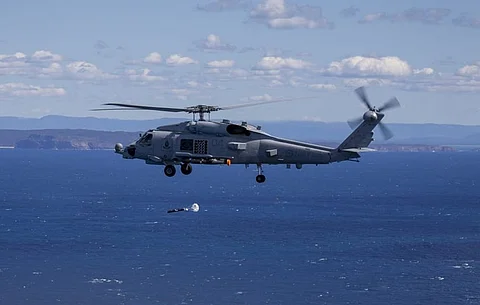

During the Cold War, it was not unheard of for Soviet ships to attempt to disrupt US naval operations by "shouldering" vessels, meaning coming abreast and colliding in a semi-controlled manner.
A famous example is the Black Sea incident of 1988, when Soviet frigates "bumped" both USS Yorktown and USS Caron as these were exercising the right of innocent passage. Only minimal damage was sustained, but a diplomatic point was made, at least from a Soviet perspective.
Why, then, are we are seeing China's military apparent focus on harassing Australian Defence Force aircraft? Is this the equivalent of a "cold shoulder"?
Most recently, on May 4, a Chinese J-10 fighter intercepted an Australian MH-60 Romeo Seahawk helicopter from the destroyer HMAS Hobart in international waters and dropped flares in its path. Suffice to say, whether it is the use of flares, aluminium chaff, or lasers as we have seen in recent times, there is no equivalent to shouldering an aircraft, and it seems only a matter of time before one is downed and Australian lives are lost.
Ironically, the explanation might not be about who flies where, or what's happening on the sea, but the least well-appreciated military domain: undersea.
While most people have an experience of flying, or have been on a ship at some point, few experience the world underneath the waves, save perhaps for snorkelling on vacation. Even those who spend their careers down there such as submariners may not know all the where's and wherefores of their operations or location (there are no portholes). So perhaps it is unsurprising the undersea domain has remained entirely out of sight and out of mind in the current discussion.
But the connection between these aircraft and the undersea domain is fundamental. Consider: an MH-60R helicopter is customised for detecting an adversary's submarines and is fitted with dipping sonar, which can be rapidly deployed and retracted from the vessel, as well as air-launched sonobuoys, which can be used to detect subs or create a protective screen for ships.
RAAF P-8 Poseidons, which have also been targeted, are similarly laden with electronics and sonobuoys, and are customised for anti-submarine warfare. Even if these aircraft are performing routine flights, their known capabilities may simply lead to the assumption by the Chinese military that they are "spying".
The location of the most recent incident is also relevant. Hobart and its helicopter were operating in international waters off the Yellow Sea, home to China's Northern Fleet, including submarine forces. Concealing its submarines and discretely accessing deep waters are seen as ongoing challenges for China.
Detection could hardly be a more important topic. While a detectable submarine is virtually useless, a stealthy one is priceless. In extremis, which nation has the stealthier submarines might be the factor upon which a future blockade or invasion of Taiwan succeeds or fails.
Detection also goes to the heart of the survivability of a Chinese second nuclear strike capability, a tremendously important strategic matter. The question of future detection technologies is also the most compelling explanation given as to why Australia abandoned a future fleet of diesel-electric submarines in favour of nuclear-powered ones.
It is therefore worth contemplating that Australia's aircraft are being targeted because of their crucial role in submarine detection and the undersea balance of power. Not only is this balance among the most important – perhaps the most important – factors for ensuring the security and stability of the Indo-Pacific in the years to come. But it would be far better building the understanding of these capabilities and interests with the Australian public now, rather than in the febrile context of a fatal incident.
